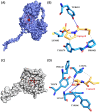Computational Insights into Captopril's Inhibitory Potential Against MMP9 and LCN2 in Bladder Cancer: Implications for Therapeutic Application
- PMID: 39315330
- PMCID: PMC11418319
- DOI: 10.1177/11769351241276759
Computational Insights into Captopril's Inhibitory Potential Against MMP9 and LCN2 in Bladder Cancer: Implications for Therapeutic Application
Abstract
Objectives: Captopril is a commonly used therapeutic agent in the management of renovascular hypertension (high blood pressure), congestive heart failure, left ventricular dysfunction following myocardial infarction, and nephropathy. Captopril has been found to interact with proteins that are significantly associated with bladder cancer (BLCA), suggesting that it could be a potential medication for BLCA patients with concurrent hypertension.
Methods: DrugBank 5.0 was utilized to identify the direct protein targets (DPTs) of captopril. STRING was used to analyze the multiple protein interactions. TNMPlot was used for comparing gene expression in normal, tumor, and metastatic tissue. Then, docking with target proteins was done using Autodock. Molecular dynamics simulations were applied for estimate the diffusion coefficients and mean-square displacements in materials.
Results: Among all these proteins, MMP9 is observed to be an overexpressed gene in BLCA and its increased expression is linked to reduced survival in patients. Our findings indicate that captopril effectively inhibits both the wild type and common mutated forms of MMP9 in BLCA. Furthermore, the LCN2 gene, which is also overexpressed in BLCA, interacts with captopril-associated proteins. The overexpression of LCN2 is similarly associated with reduced survival in BLCA. Through molecular docking analysis, we have identified specific amino acid residues (Tyr179, Pro421, Tyr423, and Lys603) at the active pocket of MMP9, as well as Tyr78, Tyr106, Phe145, Lys147, and Lys156 at the active pocket of LCN2, with which captopril interacts. Thus, our data provide compelling evidence for the inhibitory potential of captopril against human proteins MMP9 and LCN2, both of which play crucial roles in BLCA.
Conclusion: These discoveries present promising prospects for conducting subsequent validation studies both in vitro and in vivo, with the aim of assessing the suitability of captopril for treating BLCA patients, irrespective of their hypertension status, who exhibit elevated levels of MMP9 and LCN2 expression.
Keywords: Captopril; LCN2; MMP9; bladder cancer (BLCA); hypertension; inhibition; molecular dynamics simulation.
© The Author(s) 2024.
Conflict of interest statement
The author(s) declared no potential conflicts of interest with respect to the research, authorship, and/or publication of this article.
Figures







Similar articles
-
Exploring the Molecular Mechanisms and Shared Gene Signatures Between Systemic Lupus Erythematosus and Bladder Urothelial Carcinoma.Int J Gen Med. 2024 Feb 28;17:705-723. doi: 10.2147/IJGM.S448720. eCollection 2024. Int J Gen Med. 2024. PMID: 38435117 Free PMC article.
-
Bioinformatic analysis of the LCN2-SLC22A17-MMP9 network in cancer: The role of DNA methylation in the modulation of tumor microenvironment.Front Cell Dev Biol. 2022 Sep 21;10:945586. doi: 10.3389/fcell.2022.945586. eCollection 2022. Front Cell Dev Biol. 2022. PMID: 36211450 Free PMC article.
-
The Role of Emodin in the Treatment of Bladder Cancer Based on Network Pharmacology and Experimental Verification.Comb Chem High Throughput Screen. 2024;27(11):1661-1675. doi: 10.2174/0113862073294990240122140121. Comb Chem High Throughput Screen. 2024. PMID: 38504574
-
Captopril. A review of its pharmacology and therapeutic efficacy after myocardial infarction and in ischaemic heart disease.Drugs Aging. 1995 Sep;7(3):226-53. doi: 10.2165/00002512-199507030-00007. Drugs Aging. 1995. PMID: 8535052 Review.
-
Cancer-associated Fibroblasts in Bladder Cancer: Origin, Biology, and Therapeutic Opportunities.Eur Urol Oncol. 2023 Aug;6(4):366-375. doi: 10.1016/j.euo.2023.02.011. Epub 2023 Mar 6. Eur Urol Oncol. 2023. PMID: 36890105 Review.
References
-
- Zhou L, Xu J, Song Y, Gao Y, Chen X. Preparation and in vitro release performance of sustained-release captopril/chitosan-gelatin net-polymer microspheres. J Ocean Univ China. 2007;6:249-254.
-
- Lewis EJ, Hunsicker LG, Bain RP, Rohde RD. The effect of angiotensin-converting-enzyme inhibition on diabetic nephropathy. N Engl J Med. 1993;329:1456-1462. - PubMed
LinkOut - more resources
Full Text Sources
Miscellaneous

